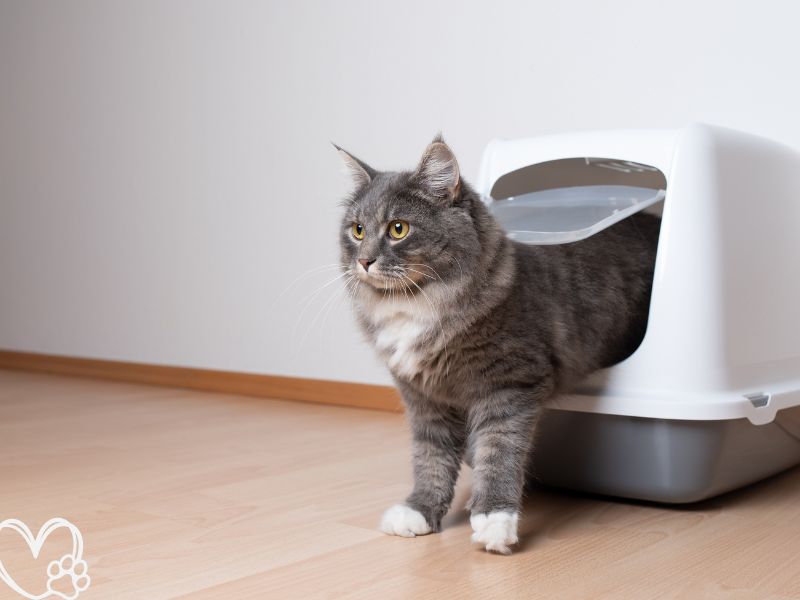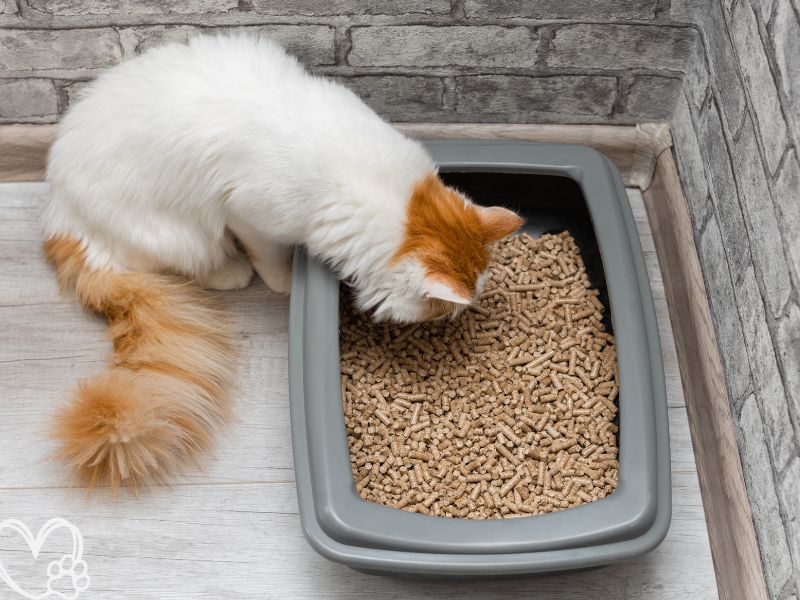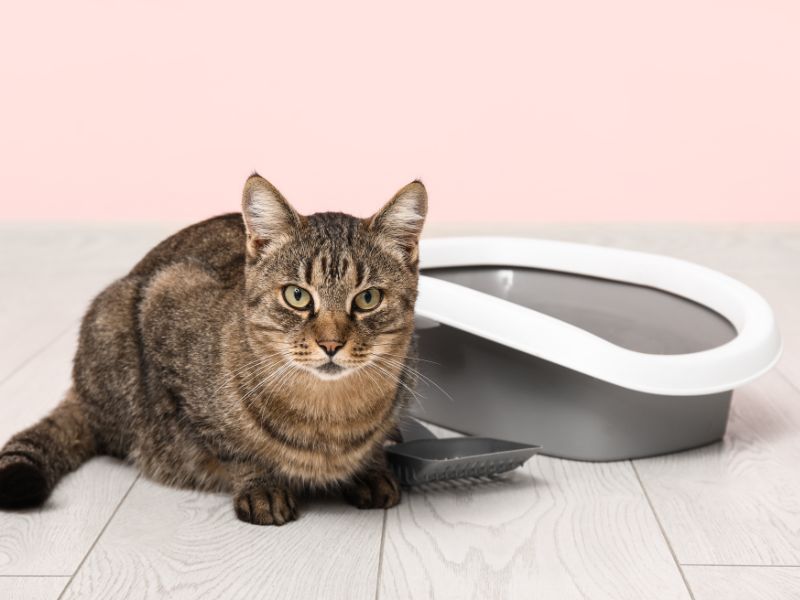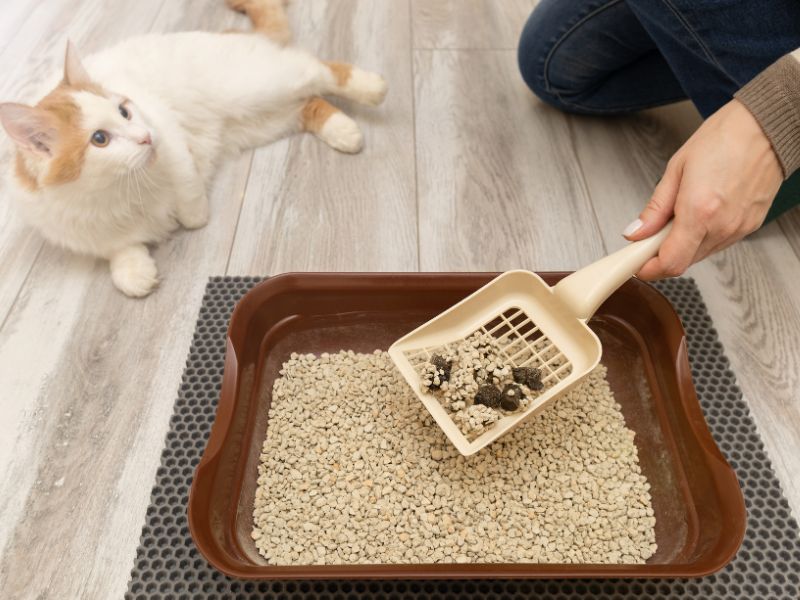Hey there, fellow cat lovers! If you’re anything like me, you know that choosing the right litter box for your feline friend is more important than it might seem. Whether you’re dealing with a finicky kitten or a senior cat with specific needs, finding the perfect litter box can make a world of difference in your cat’s comfort and your home’s cleanliness.
From the basic open pans to the latest high-tech gadgets, the variety of litter boxes available today can be overwhelming. But don’t worry—we’re here to help you navigate through all the options. In this article, we’ll explore everything from simple, affordable solutions to advanced, self-cleaning models that can make your life a lot easier. Ready to find the best litter box for your furry friend? Let’s dive in!
Why the Right Litter Box Matters?

Alright, let’s start with why picking the right litter box is such a big deal. You might think, “A litter box is a litter box, right?” Well, not exactly. Choosing the right one can make a significant difference in your cat’s health, behavior, and overall happiness.
Health and Hygiene
First off, let’s talk about health. A clean and appropriate litter box can help prevent a range of health issues for your cat. Ever noticed your cat avoiding the litter box? It might be because it’s too small, too dirty, or just not the right fit. Cats are clean animals by nature, and they prefer a tidy bathroom. A dirty litter box can lead to urinary tract infections and other health problems. So, keeping it clean and choosing a design that works for your cat can keep those vet visits to a minimum.
Behavioral Impact
Next, let’s touch on behavior. The right litter box can help reduce some common and frustrating cat behaviors. If your cat isn’t happy with their litter box, they might decide to go elsewhere—like your favorite rug. Not fun, right? A comfortable and well-placed litter box can make your cat more likely to use it consistently, saving you a lot of cleaning headaches.
Cats also need their privacy. Some cats prefer covered litter boxes where they can do their business in peace. Others might feel trapped in a covered box and prefer an open one. It’s all about knowing what makes your cat comfortable and happy.
Comfort and Privacy
Lastly, consider comfort and privacy. Just like us, cats need a comfortable space to do their business. If the litter box is too small, your cat might feel cramped and stressed. If it’s too large, they might feel exposed. Finding the right balance is key.
Also, think about where you place the litter box. It should be in a quiet, accessible spot where your cat feels safe. If you have multiple cats, you might need multiple boxes to prevent territorial issues. The rule of thumb is one litter box per cat, plus one extra.
Understanding why the right litter box matters sets the stage for exploring the different types available. Whether you’re looking for something basic or considering a high-tech solution, knowing your cat’s needs and preferences will guide you in making the best choice. Ready to dive into the various types of litter boxes? Let’s move on to the next section!
Basic Litter Boxes

Alright, let’s get into the nitty-gritty of basic litter boxes. These are the bread and butter of cat bathrooms—simple, straightforward, and easy to use. If you’re just starting out or have a no-fuss cat, a basic litter box might be just what you need.
Let’s start with the most straightforward option: the open litter box. These are the classic trays that many of us are familiar with.
- Simplicity and Ease of Use: Open litter boxes are about as simple as it gets. They’re just a basic pan where your cat can do their business. There’s nothing complicated about them, making them perfect for cats who prefer a no-frills approach.
- Affordability: These are typically the most affordable option on the market. If you’re on a budget, an open litter box is a great choice.
- Accessibility: Cats have easy access to these boxes, which is great for kittens, older cats, or any cat that might have mobility issues.
- Drawbacks: On the downside, open litter boxes don’t do much to contain odors or mess. If you have a cat that likes to kick litter around, you might find yourself sweeping up more often.
Next up, we have covered litter boxes. These come with a lid, giving your cat a bit more privacy and helping to contain messes and odors.
- Privacy for Your Cat: Some cats prefer the privacy that a covered box offers. It can make them feel more secure and less exposed.
- Odor Control: The cover helps to trap odors inside the box, keeping your home smelling fresher. Many covered boxes also come with filters to further reduce smells.
- Mess Containment: Covered boxes are great for cats that tend to scatter litter everywhere. The lid helps to keep the litter inside the box.
- Potential Downsides: However, covered boxes can also have some drawbacks. Some cats might feel claustrophobic or trapped in a covered box. They also require regular cleaning to prevent odors from building up inside.
Let’s not forget the top-entry litter boxes. These are a bit of a twist on the traditional covered box.
- Cleanliness: One major benefit is that they help keep other pets (like dogs) and small children out of the litter. Plus, they do a great job of keeping litter contained, as cats have to jump out the top and tend to shake off any excess litter on the way out.
- Space-Saving: Top-entry boxes can also be a space-saver in small apartments since they tend to have a more compact footprint.
- Training Needed: The downside? Not all cats take to them immediately. You might need to spend some time training your cat to use a top-entry box, especially if they’re used to more traditional styles.
Choosing between these basic litter box types largely depends on your cat’s preferences and your home environment. Whether you opt for the simplicity of an open box, the privacy of a covered box, or the cleanliness of a top-entry box, there’s a basic litter box out there that’s right for you and your cat.
Ready to explore some more advanced options? Let’s dive into self-cleaning litter boxes in the next section!

If you’re looking to upgrade from the basics and want to save yourself some cleaning time, self-cleaning litter boxes might be just what you need. These nifty gadgets automate the dirty work, making life easier for you and keeping the litter box cleaner for your cat.
Automated Cleaning Systems
Self-cleaning litter boxes come with automated systems that handle the scooping for you.
- How They Work: Most self-cleaning boxes have sensors that detect when your cat has used the box. After a set amount of time, a rake or conveyor system sifts through the litter, removing waste and depositing it into a sealed compartment. Some even rotate to sift litter and dispose of waste.
- Convenience for Busy Owners: If you have a busy schedule or just want to minimize your interaction with the litter box, these systems are incredibly convenient. They ensure that your cat always has a clean box to use, which can be especially helpful if you’re away from home often.
Top Models and Features
Here are a few top self-cleaning litter boxes that have earned rave reviews from cat owners:
- Litter-Robot III: This is one of the most popular and advanced self-cleaning litter boxes. It features a rotating globe that sifts the litter and deposits waste into a drawer below. It’s known for its reliability and large capacity, making it ideal for multi-cat households.
- PetSafe ScoopFree Ultra: This model uses disposable trays and a rake system to keep the litter box clean. It has adjustable settings for the cleaning cycle and comes with a privacy hood. It’s a great option if you prefer not to handle the waste at all.
- CatGenie A.I.: The CatGenie is a high-tech solution that not only cleans but also washes and dries the granules used as litter. It connects to your water and drainage system, making it a more permanent solution. It’s eco-friendly and ideal for those looking to reduce litter waste.
Considerations for Self-Cleaning Litter Boxes
While self-cleaning litter boxes offer a lot of benefits, there are some things to keep in mind:
- Noise Levels: Some models can be a bit noisy during the cleaning cycle. If your cat is skittish, look for models that are quieter.
- Maintenance: Although these boxes handle the daily scooping, they still require regular maintenance. You’ll need to empty the waste compartment and clean the unit periodically to ensure it works effectively.
- Cost: Self-cleaning litter boxes are more expensive than basic models. They’re an investment, but many cat owners find the convenience worth the price.
Pros and Cons
Pros:
- Reduces the need for daily scooping.
- Keeps the litter box consistently clean.
- Great for multi-cat households.
Cons:
- Higher upfront cost.
- Requires electricity and sometimes a connection to plumbing.
- Some cats may need time to adjust to the noise and movement.
Self-cleaning litter boxes can be a game-changer for cat owners who want to minimize the hassle of litter box maintenance. They offer a high level of convenience and help maintain a cleaner environment for your cat. Ready to take it up another notch with high-tech options? Let’s explore the world of smart litter boxes in the next section!
High-Tech Litter Boxes

For those who love incorporating the latest technology into every aspect of life, high-tech litter boxes are the way to go. These advanced litter boxes offer features that not only keep the box clean but also monitor your cat’s health and make maintaining a litter box as hands-off as possible.
High-tech, smart litter boxes take convenience to the next level by integrating technology that allows for remote monitoring and control.
- App Connectivity: Many smart litter boxes come with apps that you can download on your phone. These apps can notify you when the litter box needs attention, track your cat’s bathroom habits, and even provide data on your cat’s health. For example, the PetSafe ScoopFree Smart Litter Box connects to Wi-Fi and lets you track usage patterns and receive notifications.
- Health Monitoring: Some high-tech models, like the LavvieBot S, include features that monitor your cat’s weight and frequency of use. This information can be crucial for detecting early signs of health issues such as urinary tract infections or kidney problems.
- Customizable Settings: You can adjust the cleaning cycles, set up alerts, and monitor multiple litter boxes if you have more than one cat. This level of customization ensures that the litter box meets your specific needs and preferences.
Advanced Odor Control
One of the most significant advantages of high-tech litter boxes is their ability to manage and control odors effectively.
- Sealed Waste Compartments: Many high-tech litter boxes feature sealed compartments where waste is stored until you’re ready to dispose of it. This helps to contain odors much better than traditional open or covered boxes.
- Air Purifiers and Filters: Some models come with built-in air purifiers or advanced carbon filters that actively work to neutralize odors. For instance, the Litter-Robot III Open Air features a fully enclosed waste drawer with a carbon filter that absorbs odors.
- Automatic Sanitization: High-tech litter boxes like the CatGenie A.I. not only clean the litter but also sanitize it, ensuring that the box is as hygienic as possible for your cat.
Here are a few standout high-tech litter boxes that have impressed cat owners:
- Litter-Robot III Connect: This smart litter box offers a self-cleaning function combined with app connectivity, allowing you to monitor your cat’s usage and receive maintenance alerts. Its large capacity and efficient odor control make it ideal for households with multiple cats.
- CatGenie A.I.: The CatGenie is more than just a litter box; it’s a fully automated cat bathroom. It uses washable granules instead of traditional litter, and it connects to your water supply to clean, sanitize, and dry the granules after each use.
- PetSafe ScoopFree Smart Litter Box: This Wi-Fi-enabled litter box uses disposable trays for easy cleaning. The accompanying app lets you monitor your cat’s litter box habits and receive notifications when the tray needs to be changed.
Considerations for High-Tech Litter Boxes
Investing in a high-tech litter box comes with its own set of considerations:
- Cost: These advanced models come with a higher price tag, but the convenience and features they offer can justify the investment for many cat owners.
- Setup and Maintenance: High-tech litter boxes might require more complex setup and regular maintenance to keep all the features functioning correctly.
- Adjusting to Technology: Some cats might need time to get used to the noise and movement of automated litter boxes. Gradual introduction and positive reinforcement can help with this transition.
Pros and Cons
Pros:
- Advanced features for health monitoring and odor control.
- Convenience of remote monitoring and alerts.
- High customization for cleaning cycles and settings.
Cons:
- Higher initial and ongoing costs.
- More complex setup and maintenance.
- Potential adjustment period for your cat.
High-tech litter boxes offer a blend of convenience, advanced features, and peace of mind, making them an excellent choice for tech-savvy cat owners who want the best for their feline friends. Ready to go green and explore eco-friendly options? Let’s dive into eco-friendly and innovative litter box designs in the next section!
Eco-Friendly and Innovative Designs

For those who are environmentally conscious or looking for unique solutions to their cat’s bathroom needs, eco-friendly and innovative litter box designs offer great options. These litter boxes focus on sustainability and creativity, ensuring your cat’s comfort while minimizing environmental impact.
Eco-friendly litter boxes are designed with sustainability in mind, using materials and methods that reduce waste and environmental footprint.
- Biodegradable Materials: Some eco-friendly litter boxes are made from biodegradable or recycled materials. These options help reduce the amount of plastic waste that ends up in landfills. For example, cardboard litter boxes can be used temporarily and then composted.
- Reusable Components: Look for litter boxes with components that can be reused or easily cleaned. Stainless steel or other durable materials last longer and are more environmentally friendly than single-use plastics.
- Eco-Friendly Liners and Litter: Using biodegradable liners and eco-friendly cat litter, such as those made from recycled paper, corn, or wood, complements the sustainable design of the litter box. These products break down more easily in the environment compared to traditional clay litters.
Innovative Designs
Innovative litter box designs cater to specific needs and challenges, offering unique solutions for both cats and their owners.
- Top-Entry Litter Boxes: These litter boxes have an opening on the top, which helps reduce litter tracking and keeps other pets out. They are great for homes with dogs or small children. The design encourages cats to jump in and out, which can also help keep the surrounding area cleaner.
- Hidden Litter Boxes: Some litter boxes are designed to blend seamlessly with your home decor. For example, litter boxes disguised as furniture, such as side tables or cabinets, provide functionality without sacrificing style. These designs help keep the litter box out of sight while still being easily accessible to your cat.
- Modular Systems: Modular litter box systems allow for customization and expansion. You can add different modules, such as ramps, steps, or additional compartments, to create a setup that best suits your cat’s needs. This is particularly useful for multi-cat households or for accommodating cats with different preferences and mobility levels.
Top Eco-Friendly and Innovative Models
Here are a few top models that have impressed eco-conscious and innovative-minded cat owners:
- Modkat Litter Box: Known for its sleek, modern design and top-entry feature, the Modkat Litter Box also includes reusable liners. It’s easy to clean and reduces litter tracking, making it a favorite among stylish and practical cat owners.
- Good Pet Stuff Hidden Litter Box: This litter box is cleverly disguised as a large clay pot with a fake plant on top. It’s perfect for those who want a discreet litter box that blends into their home decor. The large size makes it suitable for bigger cats or multi-cat households.
- LitterMaid Single Cat Self-Cleaning Litter Box: Combining self-cleaning technology with an eco-friendly approach, this litter box uses biodegradable waste receptacles and carbon filters to control odors. It’s an excellent option for those looking for convenience and sustainability.
Considerations for Eco-Friendly and Innovative Litter Boxes
While these litter boxes offer many benefits, there are some factors to keep in mind:
- Cost: Innovative and eco-friendly designs can be more expensive than basic models. However, the investment often pays off in terms of convenience, sustainability, and longevity.
- Maintenance: Some eco-friendly litter boxes, especially those made from biodegradable materials, might require more frequent replacement or maintenance to keep them in good condition.
- Adjusting to New Designs: Cats might need time to adjust to new and unconventional litter box designs. Gradual introduction and positive reinforcement can help your cat get comfortable with their new setup.
Pros and Cons
Pros:
- Environmentally friendly materials and design.
- Unique and customizable solutions.
- Aesthetic appeal and functionality.
Cons:
- Higher upfront costs.
- Potentially more frequent maintenance.
- Adjustment period for some cats.
Eco-friendly and innovative litter boxes provide excellent alternatives for cat owners who prioritize sustainability and creativity. These options ensure that you can meet your cat’s needs while also considering the environment and the aesthetics of your home. Ready to find the perfect litter box for your cat? Let’s explore how to choose the right one in the next section!
Choosing the Right Litter Box for Your Cat

With so many options available, selecting the perfect litter box for your cat can feel overwhelming. But don’t worry—we’ve got you covered. Here’s how to find the best fit for your feline friend by considering their needs, your space, and practical aspects of each type of litter box.
Assessing Your Cat’s Needs
Every cat is unique, and their preferences can vary based on several factors.
- Size and Age: Kittens and smaller cats may prefer smaller, low-sided litter boxes that are easy to access. Larger cats, on the other hand, need bigger boxes to move around comfortably. Senior cats or those with mobility issues might benefit from boxes with lower entry points or ramps.
- Personality and Behavior: Observe your cat’s behavior. Do they seem to prefer open spaces or more secluded areas? Some cats feel more secure with covered boxes, while others might feel trapped and prefer open ones. Cats that are highly active or playful might enjoy top-entry or self-cleaning boxes that provide a bit more engagement.
- Health Considerations: If your cat has specific health issues, such as arthritis or urinary problems, choosing a litter box that minimizes their discomfort is crucial. For instance, a self-cleaning litter box can help keep the box consistently clean, reducing the risk of infections.
Space and Location
Where you place the litter box in your home can significantly impact your cat’s willingness to use it.
- Quiet and Accessible: Choose a location that is quiet and offers some privacy but is still easily accessible. Avoid placing the litter box in high-traffic areas or near loud appliances that might startle your cat.
- Multi-Cat Households: If you have more than one cat, the general rule is to have one litter box per cat plus one extra. This helps prevent territorial disputes and ensures that each cat has a clean space to use. Spread the litter boxes around the house so each cat has their own designated area.
- Small Spaces: In smaller homes or apartments, consider space-saving designs like top-entry boxes or hidden litter boxes that can double as furniture. These designs maximize your space while keeping the litter box discreet.
Practical Considerations
Here are some practical aspects to consider when choosing a litter box:
- Ease of Cleaning: Look for litter boxes that are easy to clean and maintain. Self-cleaning boxes require less daily maintenance but might need more periodic deep cleaning. Simple open or covered boxes should have smooth surfaces that are easy to wipe down.
- Odor Control: If odor control is a significant concern, opt for litter boxes with sealed waste compartments or those that come with carbon filters. High-tech options often have advanced odor control features, while some eco-friendly designs use natural materials to minimize smells.
- Durability and Quality: Investing in a high-quality litter box can save you money in the long run. Durable materials like high-grade plastic, stainless steel, or robust composites ensure the litter box withstands daily use without cracking or breaking.
Tips for Choosing the Right Litter Box
- Trial and Error: Don’t be afraid to try different types of litter boxes to see which one your cat prefers. It might take a few attempts to find the perfect fit.
- Start Simple: If you’re unsure, start with a basic open or covered litter box. You can always upgrade to a more advanced or specialized box once you understand your cat’s preferences better.
- Listen to Your Cat: Pay attention to your cat’s behavior and body language. If they seem hesitant to use a new litter box, try to identify what might be bothering them and make adjustments accordingly.
By considering your cat’s needs, your living space, and practical aspects, you can choose the ideal litter box that keeps both you and your cat happy. Ready to ensure your chosen litter box stays in top condition? Let’s move on to maintenance and care tips in the next section!
Maintenance and Care Tips

Choosing the right litter box is just the first step. To keep your cat healthy and happy, and to ensure the longevity and cleanliness of the litter box, proper maintenance is crucial. Here are some practical tips to help you maintain your cat’s litter box.
Regular Cleaning Routine
Keeping the litter box clean is essential for your cat’s health and hygiene.
- Daily Scooping: Scoop out solid waste and clumps of urine daily. This prevents odors from building up and keeps the litter box inviting for your cat. Use a good quality scoop that can easily sift through the litter.
- Weekly Deep Cleaning: At least once a week, empty the litter box completely and wash it with mild soap and warm water. Avoid using harsh chemicals or strong-smelling cleaners that could deter your cat from using the box.
- Dry Thoroughly: Make sure the box is completely dry before adding fresh litter. Cats have a strong sense of smell, and any leftover moisture or cleaning product residue can be off-putting.
Long-Term Care
In addition to daily and weekly maintenance, consider these long-term care tips:
- Regular Inspections: Check the litter box regularly for signs of wear and tear. Look for cracks or rough spots that could harbor bacteria or make cleaning difficult.
- Replace When Necessary: Even the best litter boxes have a lifespan. If you notice that the box is becoming too scratched or damaged to clean effectively, it’s time to replace it. For self-cleaning or high-tech litter boxes, follow the manufacturer’s recommendations for part replacements and maintenance.
- Maintain High-Tech Features: If you’re using a high-tech or self-cleaning litter box, ensure that all sensors and moving parts are functioning correctly. Clean these components as directed in the user manual to keep the system running smoothly.
Tips for Specific Litter Box Types
Different types of litter boxes require different care routines.
- Self-Cleaning Litter Boxes: For self-cleaning models, empty the waste compartment regularly and clean the rakes or rotating mechanisms as needed. Keep the sensors free of dust and litter to ensure accurate operation.
- Covered Litter Boxes: If you have a covered box, clean the cover along with the base to prevent odor buildup. Pay extra attention to corners and crevices where litter and waste can accumulate.
- Top-Entry Litter Boxes: For top-entry boxes, clean the entry hole and the top surface where your cat jumps in and out. This helps reduce litter tracking and keeps the area around the box cleaner.
Choosing the Right Cleaning Products
Using the right cleaning products is important for maintaining the litter box and ensuring your cat’s safety.
- Mild Detergents: Use mild, unscented detergents or soaps. Strong chemicals or fragrances can deter your cat from using the box.
- Natural Cleaners: Consider natural cleaners like vinegar and baking soda for an eco-friendly option. These are effective at neutralizing odors and are safe for your cat.
- Disinfectants: Occasionally, you may want to disinfect the litter box, especially if you have multiple cats or if your cat has been ill. Use a pet-safe disinfectant and rinse thoroughly to remove any residue.
Managing Odors
Keeping odors under control is a common concern for cat owners. Here’s how to manage them effectively:
- Use Odor Control Litter: Choose a high-quality, odor-control cat litter. Clumping litters often help with odor management by making it easier to remove waste.
- Add Baking Soda: Sprinkle a layer of baking soda at the bottom of the litter box before adding fresh litter. Baking soda helps neutralize odors naturally.
- Ventilation: Ensure the area where the litter box is placed is well-ventilated. This helps disperse any lingering smells and keeps the air fresh.
- Activated Charcoal: Consider using activated charcoal filters or placing a small container of activated charcoal near the litter box to absorb odors.
Final Tips
- Consistency is Key: Regular cleaning and maintenance are crucial for a healthy and happy cat. Consistency will keep odors at bay and make the litter box a pleasant place for your cat.
- Observe Your Cat: Pay attention to how your cat reacts to the litter box. If they seem reluctant to use it, check for cleanliness or possible issues with the box itself.
- Stay Informed: Keep up with new products and techniques in litter box maintenance. There are always new innovations that can make the process easier and more effective.
By following these maintenance and care tips, you can ensure your cat’s litter box remains clean, odor-free, and inviting. This not only keeps your home smelling fresh but also promotes your cat’s health and happiness. Ready to wrap things up? Let’s move on to the conclusion!
Conclusion
Choosing the right litter box for your cat is essential for their comfort, health, and happiness. From basic models to high-tech options, there’s a perfect fit for every cat and owner. By considering your cat’s unique needs and maintaining the litter box properly, you can ensure a clean and pleasant environment for both you and your feline friend. Happy litter box hunting!



Hey people!!!!!
Good mood and good luck to everyone!!!!!